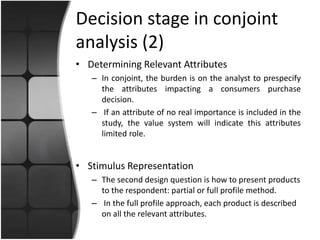The document discusses various methods for conducting market analysis for new product development. It focuses on four main areas: idea generation, product optimization, marketing mix optimization, and market prediction. For idea generation, methods like brainstorming, focus groups, and morphological analysis are presented. Product optimization discusses approaches like Quality Function Deployment (QFD) and conjoint analysis to design the product based on customer needs. Test marketing and concept testing are described as ways to introduce the new product to the market and predict its anticipated success. Case studies on pharmaceutical companies and automakers are provided as examples.






























![Diffusion models (2)
• The probability that an initial purchase will
be made at T given that no purchase has
yet been made is a linear function of the
number of previous buyers.
P(T) p (q /m)Y(T)
2 S(T) pm (q p)Y(T) q /m[Y(T)]
• If the coefficient of imitation is greater
than the coefficient of innovation the
solution rises to a peak and then declines.
• Figure growth of new product](https://image.slidesharecdn.com/npd-141015193113-conversion-gate01/85/Npd-31-320.jpg)






